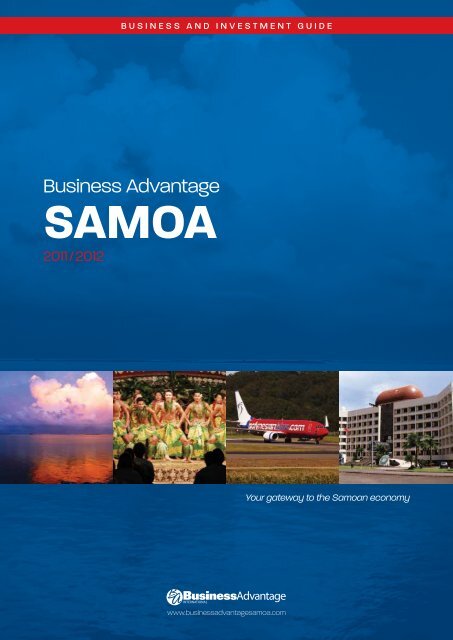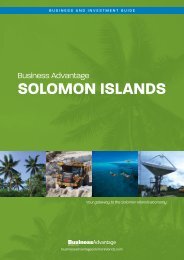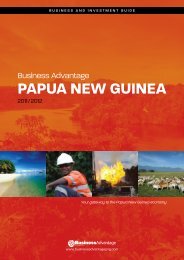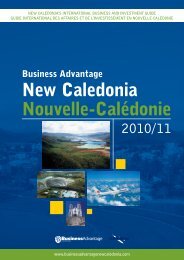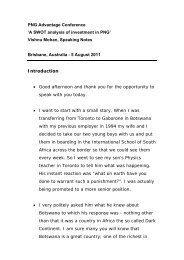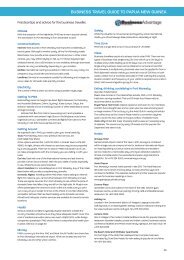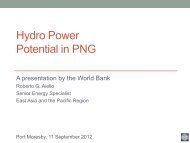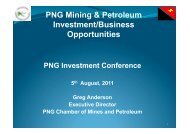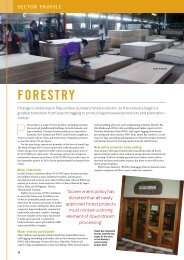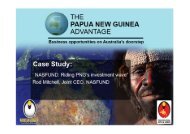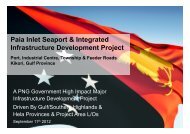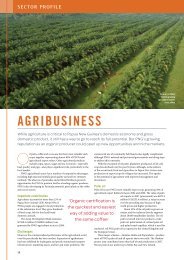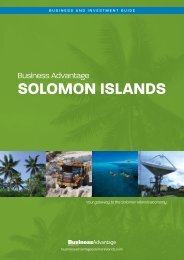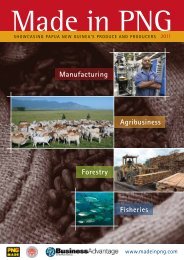Business Advantage Samoa 2011/2012 - Ministry of Commerce ...
Business Advantage Samoa 2011/2012 - Ministry of Commerce ...
Business Advantage Samoa 2011/2012 - Ministry of Commerce ...
You also want an ePaper? Increase the reach of your titles
YUMPU automatically turns print PDFs into web optimized ePapers that Google loves.
BUSINESS AND INVESTMENT GUIDE<strong>Business</strong> <strong>Advantage</strong>SAMOA<strong>2011</strong>/<strong>2012</strong>Your gateway to the <strong>Samoa</strong>n economy1 www.businessadvantagesamoa.com
Surrounded by the glistening Pacific, lies <strong>Samoa</strong>.Touch down and you step back in time.You see <strong>Samoa</strong>ns adhere to a 3,000 year old way<strong>of</strong> life, called Fa’a <strong>Samoa</strong> which respects family,community and visitors. No wonder it was the locationfor the Survivor mini-series.But whilst <strong>Samoa</strong>n values are timeless, their facilitiesare up to date and can accommodate a board meetingfor a dozen or a conference for three hundred.Fa’a <strong>Samoa</strong>. The <strong>Samoa</strong>n way.www.samoa.travel2
BUSINESS ADVANTAGE SAMOA CONTENTS4ECONOMIC UPDATEOur survey <strong>of</strong> <strong>Samoa</strong>’s business leaders brings you up-to-date withthe current state <strong>of</strong> its economy and the opportunities for doingbusiness in this picturesque South Pacific country.8INTERVIEW WITH SAMOA’S PM<strong>Samoa</strong> has led the Pacific region with pro-business reform. <strong>Samoa</strong>’sPrime Minister, the Hon. Tuilaepa Lupesoliai Sailele Malielegaoi MP,identifies the prospects for future reform.1611 PRODUCTIVE SECTORSWe pr<strong>of</strong>ile <strong>Samoa</strong>’s manufacturing, agribusiness andfisheries sectors as <strong>Samoa</strong> prepares to accede to theWorld Trade Organisation.14 WHO’S WHO IN SAMOAN BUSINESSA handy reference to the key players and business/government organisations.22 BANKING AND FINANCEWith its International Finance Centre—the first Pacificcentre to be white-listed by the OECD—and a wellstructuredfinancial services sector, <strong>Samoa</strong> is wellplacedto service the needs <strong>of</strong> both local and <strong>of</strong>fshorebusinesses.24 INFRASTRUCTURE AND TRANSPORT<strong>Samoa</strong> has done much to remove the tyranny <strong>of</strong> distanceand is increasingly becoming one <strong>of</strong> the key transportationand telecommunications hubs for the region. Improvedbroadband connectivity will also <strong>of</strong>fer new businessopportunities.26 BUSINESS TRAVEL GUIDE TO SAMOAHandy tips and advice for the business traveller.QUINTESSENTIAL SOUTH PACIFIC<strong>Samoa</strong>'s tourism sector is emerging from the September 2009tsunami and global downturn in better shape than ever.This publication is made possible through the support <strong>of</strong> the following organisations:SAMOA TOURISM AUTHORITY<strong>Ministry</strong> <strong>of</strong> <strong>Commerce</strong>,Industry & Labour<strong>Business</strong> <strong>Advantage</strong> <strong>Samoa</strong> is published by <strong>Business</strong> <strong>Advantage</strong> International Pty Ltd,Level 27, Rialto South Tower, 525 Collins St, Melbourne, Victoria 3000, Australia, tel +613 9935 2977, fax +61 3 9935 2750. www.businessadvantage.coThis publication is available free online at www.businessadvantagesamoa.com.Additional printed copies can be purchased for AUD$35.00 (incl GST and postage)from the above address or by emailing info@businessadvantageinternational.com.© Copyright <strong>2011</strong> <strong>Business</strong> <strong>Advantage</strong> International Pty LtdProject Director: Robert Hamilton-Jones (rhj@businessadvantageinternational.com)Publisher: Andrew Wilkins (aw@businessadvantageinternational.com)Editorial: Jacqueline BennettDesign: Michael RengaCover images: <strong>Business</strong> <strong>Advantage</strong> International, kirklandphotos.com/<strong>Samoa</strong> TourismAuthority, Polynesian BluePublished in partnership with the Government <strong>of</strong> <strong>Samoa</strong>.<strong>Business</strong> <strong>Advantage</strong> would like to acknowledge the assistance and goodwill <strong>of</strong><strong>Samoa</strong>’s Prime Minister, the Hon. Tuilaepa Lupesoliai Sailele Malielegaoi MP andDeputy Prime Minister, the Hon. Misa Telefoni.Printed in Australia. Both printer and paper manufacturer for this publication are accredited to ISO14001, theinternationally-recognised standard for environmental management. This publication is printed using vegetableinks and the stock is elemental chlorine free and manufactured using sustainable forestry practices.About this publication<strong>Business</strong> <strong>Advantage</strong> <strong>Samoa</strong> is produced regularly to provide a guide to doingbusiness in <strong>Samoa</strong>. It provides a reader-friendly overview <strong>of</strong> economic conditions,assesses business opportunities and imparts practical advice.DISCLAIMER<strong>Business</strong> <strong>Advantage</strong> <strong>Samoa</strong> is a general guide to some potential business opportunities in <strong>Samoa</strong> and is notdesigned as a comprehensive survey. The opinions expressed herein are not necessarily those <strong>of</strong> the publisherand the publisher does not endorse any <strong>of</strong> the business or investment opportunities featured, nor does it acceptany liability for any costs or losses related to dealings with entities mentioned in this publication. Readers arestrongly advised to pursue their own due diligence and consult with investment advisors before making anyinvestment decisions.3
ECONOMIC UPDATE<strong>Samoa</strong>’s capital city, ApiaRegaining momentum<strong>Business</strong> <strong>Advantage</strong>’s Andrew Wilkins surveyed government and business leaders in <strong>Samoa</strong> to reveal acountry recovering slowly but surely from the impacts <strong>of</strong> global financial crisis and a devastating tsunami.> Economically and politically stable democracy> Strategically located at the heart <strong>of</strong> the South Pacific> Opportunities in tourism, agribusiness, fisheries,manufacturing and services> Reliable infrastructure> A regional leader in economic reform> Educated, English-speaking workforce> Competitive Offshore Finance CentreUntil the 2008/9 global financial crisis and anespecially destructive tsunami which hit thesouthern part <strong>of</strong> the main island, Upolu, inSeptember 2009, <strong>Samoa</strong> had been on an impressiveupward path arguably since the reformist HumanRights Protection Party entered government followinga financial crisis in the late 1970s and early 1980s.The consensus among business leaders <strong>Business</strong> <strong>Advantage</strong>spoke to in late 2010 was that the domestic economy has undoubtedlyslowed—remittances from overseas (see page 22) have dropped,reducing domestic demand, and consequently slowing demand forcredit from businesses.While it has temporarily reined in <strong>Samoa</strong>’s previously impressivegrowth, the economic slowdown has at least enabled <strong>Samoa</strong> to gaina three-year extension to its Least Developed Nation status from theUnited Nations (UN)—an extension which will enable it to continue toaccess UN development programs.Improved Prospects For GrowthWhile some economic slowdown has been inevitable, the advent <strong>of</strong>millions <strong>of</strong> dollars <strong>of</strong> post-tsunami foreign aid, a Government stimuluspackage targeting the agribusiness and fisheries sectors, and theintroduction <strong>of</strong> significant economic and business-related reforms prior‘The tourism sector is now recognisedas having the key role in <strong>Samoa</strong>’s futureeconomic development.’to 2008/9 (see page 8) means that the <strong>Samoa</strong>n economy is wellplacedfor future growth. The Central Bank <strong>of</strong> <strong>Samoa</strong> anticipates 3%GDP growth in 2010, and similar growth thereafter.‘<strong>Samoa</strong>’s historic shift [in September 2009] from right-hand to lefthanddrive also created a lot <strong>of</strong> business activity, with people importingcars, and roads being fixed up,’ observes Malcolm Johnston, President <strong>of</strong>the Banker’s Association <strong>of</strong> <strong>Samoa</strong>.Certainly, conditions for business lending have improved markedly.‘Interest rates are at all all-time low and there is a high level <strong>of</strong> liquidityin the banking system,’ says Steve Rogers, Chief Executive Officer <strong>of</strong>ANZ Bank (<strong>Samoa</strong>), <strong>Samoa</strong>’s largest commercial bank.‘We are very optimistic for the remainder <strong>of</strong> the 2010/11 financialyear,’ <strong>Samoa</strong>n National Provident Fund’s CEO Faumuina Esther LamekoPoutoa told <strong>Business</strong> <strong>Advantage</strong>. ‘Even though <strong>Samoa</strong> felt the effects<strong>of</strong> the global economic crisis, our fund still managed a 12.5% increasein net pr<strong>of</strong>it for the 2009/10 financial year. Towards the end <strong>of</strong> 2010, wesaw a 10% increase in active employers and a 7% increase in activeemployees—people who are actually working.’Tourism the key sectorTourism is <strong>Samoa</strong>’s largest industry, and has gone from strength tostrength in recent years, particularly since the commencement <strong>of</strong> flightsby new international airline Polynesian Blue in 2005.While most tourism-related businesses are <strong>of</strong> a small scale, tsunamidamagedresorts have been rebuilt bigger and better than before andseveral larger projects are increasing capacity significantly (see page 16for more on this sector).<strong>Samoa</strong>’s Deputy Prime Minister and Minister or <strong>Commerce</strong>, Industryand Labour, the Hon Misa Telefoni, sees these major projects asevidence that <strong>Samoa</strong>’s strategies to attract foreign investment to thesector are working:4
ECONOMIC UPDATEMODERN SAMOAA peaceful democracy within the Commonwealth <strong>of</strong>Nations, the Independent State <strong>of</strong> <strong>Samoa</strong> (known priorto 1997 as Western <strong>Samoa</strong>) sits strategically at thecentre <strong>of</strong> the South Pacific, with Australia to its west,New Zealand to the south, Hawai’i to the north andFrench Polynesia to the east.While just 181,000 <strong>Samoa</strong>ns inhabit the country itself, manythousands more live in New Zealand, the United States andAustralia.Historically, the country is possibly best known as the final restingplace <strong>of</strong> Treasure Island author Robert Louis Stevenson, who wroteextensively <strong>of</strong> the country in his final years. It was also the one<strong>of</strong> the major staging points for US military operations during theSecond World War (memorably recorded in James Michener’s Tales<strong>of</strong> the South Pacific—literary source for the celebrated Rodgers andHammerstein musical, South Pacific).More recently, <strong>Samoa</strong> has been a location for the popularUS television show Survivor, and the country’s extraordinarilysuccessful rugby union teams have become roving ambassadorsfor the country (Manu <strong>Samoa</strong> won the IRB Sevens Rugby WorldSeries in 2009/10).While it has retained the quintessential elements <strong>of</strong> a South Pacificparadise—pristine waters, a lush interior, palm-lined beaches, astrong traditional culture and a pleasant maritime climate—modern<strong>Samoa</strong> also has one <strong>of</strong> the most attractive business environmentsin the Pacific region, with modern ICT infrastructure, regular air andsea services connecting it to major markets, reliable ports andresponsive Government agencies.<strong>Samoa</strong> is also a major centre for <strong>of</strong>fshore finance in the Pacific, withthe <strong>Samoa</strong> International Finance Authority facilitating business for manyinternational companies each year (see page 23).Obstacles to growthWhile the worst impacts <strong>of</strong> the global financial crisis and the tsunamihave now been mitigated, key challenges nominated by businessleaders <strong>Business</strong> <strong>Advantage</strong> spoke with include the need for furtherland reform to release more land for commercial development (see Page8), the need for more education and training, and the need for greateraccess to major markets such as Australia and New Zealand, whosestrict quarantine requirements tend to restrict agricultural exports. Thehigh cost <strong>of</strong> imports due to <strong>Samoa</strong>’s distance from major markets is alsoan issue, although the <strong>Samoa</strong>n Government <strong>of</strong>fers relief from importduties for new investments. While the Companies Act has recently beenrevised, some updating <strong>of</strong> other business-related laws is also seen asdesirable.The <strong>Samoa</strong>n Government is certainly treating education as a priority,with its SchoolNet program rolling out internet connectivity to schoolsand undergraduate and vocational training now taking place at severalinstitutions, including the National University <strong>of</strong> <strong>Samoa</strong>.Removing the isolationClearly, modern <strong>Samoa</strong> is connecting the rest <strong>of</strong> the world economyin ways unimaginable to previous generations. Perhaps most notableexample <strong>of</strong> this for the business visitor to <strong>Samoa</strong> is in the area <strong>of</strong>mobile telephony and internet access. Since <strong>Business</strong> <strong>Advantage</strong> lastvisited <strong>Samoa</strong> in 2008, ICT infrastructure has improved exponentially.Broadband internet is now commonplace, as are reliable andcompetitive mobile phone services.The <strong>Samoa</strong>n Government has committed itself to building a NationalBroadband Network to build on these achievements—a developmentthat will see the expansion <strong>of</strong> <strong>Samoa</strong> into the new information economyand the delivery <strong>of</strong> more Government services online, includingbusiness registration. As <strong>Samoa</strong>’s Prime Minister, the Hon. TuilaepaLupesoliai Sailele Malielegaoi MP, tells <strong>Business</strong> <strong>Advantage</strong>:‘It is the only way we in the Pacific can terminate that sense <strong>of</strong>isolation we grew up with.’<strong>Samoa</strong>’s National Parliament6
ECONOMIC UPDATEIn a perfect world,your bank would <strong>of</strong>fer youconnections, not just products.With <strong>of</strong>fices in 28 countries and territories across Asia Pacific,talk to the bank that connects you to people who know people.For more information, please contact ANZ <strong>Samoa</strong>PO Box L1855, Apia, <strong>Samoa</strong>T. +685 69999 [8am to 5pm on normal business days]F. +685 24595T. +685 69975 [Card enquiries helpdesk during working hours]T. 800199 [Card enquiries helpdesk during weekends & after hours]ANZ Swift Code. ANZBWSWW BSB. 010 979anz.com/samoa7Australia and New Zealand Banking Group Limited (ANZ) ABN 11 005 357 522
ECONOMIC UPDATEMAKING SAMOA ATTRACTIVE FOR BUSINESS<strong>Samoa</strong>’s Prime Minister, the Hon. Tuilaepa Lupesoliai Sailele Malielegaoi MP, waspreparing to face March <strong>2011</strong> parliamentary elections when <strong>Business</strong> <strong>Advantage</strong>interviewed him.The first Pacific Islands country to achieveindependence back in 1962, <strong>Samoa</strong> has also led theregion in business-related reforms. <strong>Business</strong> <strong>Advantage</strong>spoke with Prime Minister the Hon. Tuilaepa LupesoliaiSailele Malielegaoi MP about the path <strong>of</strong> reform.Since 1998, the Government <strong>of</strong> Prime Minister the Hon. TuilaepaLupesoliai Sailele Malielegaoi MP has been responsible for drivingreforms in several areas. The number <strong>of</strong> Government departmentshas been cut from 28 to 13, corporate tax rates have been reducedfrom 45% to 27%, import duties have been cut dramatically and a15% Value Added Goods and Services Tax has been introduced. In2009, <strong>Samoa</strong>ns also switched from driving on the right hand side <strong>of</strong>the road to the left, in order to bring it into line with most <strong>of</strong> its Pacificneighbours, including Australia and New Zealand, its two majorsources <strong>of</strong> visitors.Privatisation <strong>of</strong> state assets and the introduction <strong>of</strong> competitionin key sectors has also been a high priority. The previouslyGovernment-owned Vailima Brewery is now part <strong>of</strong> Australia’sFoster’s Group, the advent <strong>of</strong> international airline Polynesian Bluehas increased competition in the country’s aviation sector, whileCaribbean-based mobile phone company Digicel became theharbinger <strong>of</strong> competition in the telecommunications sector when itchose <strong>Samoa</strong> as its first Pacific location in October 2006 through itsacquisition <strong>of</strong> Telecom <strong>Samoa</strong> Cellular Ltd.‘A key element <strong>of</strong> our reform agenda has been the privatisation ourmajor public enterprises,’ notes Prime Minister the Hon. TuilaepaLupesoliai Sailele Malielegaoi MP, asked by <strong>Business</strong> <strong>Advantage</strong>to nominate key reforms. ‘We still have a few more to privatise: theAgriculture Store Corporation, for instance, and <strong>Samoa</strong>Tel [at thetime <strong>of</strong> writing due for privatisation in the first quarter <strong>of</strong> <strong>2011</strong>].’At the same time, the <strong>Samoa</strong> Government has started the process<strong>of</strong> removing ministers and public servants from the boards <strong>of</strong> publiccorporations.‘We are bringing in people from the private sector to run thesecorporations,’ says the Prime Minister, who has himself relinquishedchairmanship <strong>of</strong> both Polynesian Airlines and the Totalisator AgencyBoard by way <strong>of</strong> example.While such moves might be seen as textbook economic reforms,they have a <strong>Samoa</strong>n flavour, underpinned by an understandingthat the market alone cannot provide all the solutions in a smallisland economy. The planned privatisation <strong>of</strong> <strong>Samoa</strong>Tel (see page25), for example, has been preceded by the creation <strong>of</strong> the UnitTrust <strong>of</strong> <strong>Samoa</strong>. Says the Hon. Tuilaepa Lupesoliai Sailele Malielegaoi:‘We made a stipulation that, before <strong>Samoa</strong>Tel was sold, we mustfirst <strong>of</strong> all create a unit trust so that part <strong>of</strong> the shares <strong>of</strong> thecompany would be reserved for the local people.’The Government also introduced a stimulus package in 2009to counter the joint impact <strong>of</strong> the 2009 tsunami and the globalfinancial crisis. Measures included programs to encourage forestryplantations and related infrastructure, and the replanting <strong>of</strong> cocoa,c<strong>of</strong>fee and coconut.‘Only those planters that use organic systems could participatein the program. By going organic, we can expect better premiumprices for our primary products if exported,’ says the Prime Minister.‘At the same time, we have also established Scientific ResearchOrganisation <strong>of</strong> <strong>Samoa</strong> to help us address the question <strong>of</strong> how wecan generate more exports without being impacted by the toughquarantine regulations <strong>of</strong> countries like Australia and New Zealand.The only answer is to develop and strengthen our research.’USING LAND FOR BUSINESS IN SAMOALand has a special status in <strong>Samoa</strong>, as it does in mostPacific Island countries. Under the country’s landclassification system, about 80% <strong>of</strong> all land is customaryland, with the remainder either freehold (about 12%) orheld by the Government.The implications for business are several. Customary land, which isheld under ‘Chiefly Titles’, cannot be bought and sold. The standardway <strong>of</strong> obtaining customary land for business use therefore isthrough long-term leases that must be negotiated with localcommunities. A typical lease for business use might be for 30 years,with the option <strong>of</strong> a further 30 years after that, although longer termscan be negotiated.It should be noted that customary land cannot be mortgaged, andthus cannot be used as collateral to raise capital or credit. This isseen as brake to development. While there is land reform occurringin <strong>Samoa</strong> (the internationally prevalent Torrens system <strong>of</strong> land titleregistration was adopted in 2008), the process <strong>of</strong> reform in this areais necessarily slow.Freehold land (mostly based in and around the capital, Apia) can bebought, sold and mortgaged, but is scarce. Only <strong>Samoa</strong>n residentsmay buy freehold land (unless approval is obtained from <strong>Samoa</strong>’sHead <strong>of</strong> State).8
ECONOMIC UPDATEPerspectives on <strong>Samoa</strong><strong>Business</strong> leaders provide their own views on the current business climate.‘We are continuing to participate actively in effortsto promote the opportunities for growth availablethrough a free and competitive market. We believeour private sector will be the engine <strong>of</strong> growth forour economy, and we must ensure an enablingenvironment to faciliate this.’—The Hon. Misa Telefoni, Deputy Prime Minister‘There are good opportunities to increase thenumber and volume <strong>of</strong> <strong>Samoa</strong>’s exports. It hasa well-educated population with good Englishand there are also opportunities with its rapidlyimproving ICT infrastructure to develop back <strong>of</strong>ficeservices such as call centres.’—Caleb Jarvis, Trade Commissioner, Pacific Islands Trade & Invest‘In 2010/11, the economy is expected to record a stronger recovery <strong>of</strong>up to 3%, followed by further growth rates <strong>of</strong> around 2% per annumin the following two financial years. In addition to the continuation<strong>of</strong> the Central Bank <strong>of</strong> <strong>Samoa</strong>’s easy monetary policy stance andimprovements in the New Zealand and Australian economies, thispositive outlook for the <strong>Samoa</strong>n economy is also based on theGovernment’s highly expansionary Budget for 2010/11. The expectedpickup in exports and the recovery in tourism activity following thereconstruction <strong>of</strong> the resorts that were affected by the tsunami shouldalso contribute positively to economic growth.’—Leasi Scanlan, Governor, Central Bank <strong>of</strong> <strong>Samoa</strong>‘From a political and economic perspective, wehave stability. The Central Bank has led with astable economic policy and interest rates areat an all-time low. There was real growth in theeconomy—double-digit growth—up to the 2007South Pacific Games. While the global financialcrisis and the tsunami have impacted growth in recent years, there havebeen some promising signs for <strong>Samoa</strong>, particularly in relation to tradewith Asia.—Steve Rogers, CEO, ANZ Bank (<strong>Samoa</strong>) Ltd‘Following the October 2009 tsunami, people have wanted to get backinto business and get back fast. I’ve been quite amazed at how quicklyit’s happened. It’s a wonderful example <strong>of</strong> how resilient the <strong>Samoa</strong>npeople can be.’—John Perrottet, international tourism advisory firm Perrottet Partners'When Polynesian Blue was launched in 2005,it was not only to build a pr<strong>of</strong>itable internationalcarrier for the people <strong>of</strong> <strong>Samoa</strong> but to build onethat has a strong sense <strong>of</strong> community involvementand responsibility. With <strong>Samoa</strong> being an emergingtourism destination, as well as having strong familylinks with New Zealand and Australia, the capacity has grown to sixflights a week between Auckland and Apia, three flights a week betweenSydney and Apia, and one flight a week between Brisbane and Apia.Due to demand from the business traveller we have added a newcabin class, Premium Economy. This <strong>of</strong>fers guests an enhanced flyingexperience, including more spacious seating, complimentary food andbeverages, priority check-in and a flexible and refundable fare.Polynesian Blue looks forward to growing visitor numbers to <strong>Samoa</strong>and continuing to play an active role in developing its tourism industry.'—Mark Pitt, CEO, Polynesian Blue AirlinesDOING BUSINESS IN SAMOA<strong>Business</strong> <strong>Advantage</strong> asked Arthur Penn <strong>of</strong> localaccountants Lesa Ma Penn to summarise therequirements for doing business in <strong>Samoa</strong>.Company registrationA company must be registered under theCompanies Act 2001 (amended 2006) toconduct business in <strong>Samoa</strong>. An overseascompany can register with the <strong>Ministry</strong> <strong>of</strong>Arthur Penn <strong>Commerce</strong>, Industry and Labour under the Actas either a Local Company or as an OverseasCompany. Registered companies receive a Foreign InvestmentCertificate and <strong>Business</strong> Licence. (For further information, visit www.mcil.gov.ws)Company tax<strong>Samoa</strong>’s corporate tax rate is currently 27%.SuperannuationSuperannuation is compulsory for all employees working in <strong>Samoa</strong>or employed overseas by a company or an organisation registeredin <strong>Samoa</strong>. Exemptions can be made for foreigners working in <strong>Samoa</strong>who can prove that they are part <strong>of</strong> a similar superannuationscheme. A minimum superannuation payment <strong>of</strong> 10% <strong>of</strong> anemployee’s gross salary must be paid to the <strong>Samoa</strong> NationalProvident Fund. The employer contributes 5% and the employeethe other 5%.Accident Compensation LevyAn Accident Compensation Levy <strong>of</strong> 2% is payable to the AccidentCompensations Corporation for all employees, whether <strong>Samoa</strong>nor expatriates; 1% to be paid by the employer and 1% by theemployee.Medical insuranceAlthough a 3% medical insurance levy has been suggested, thereis currently no compulsory medical cover in <strong>Samoa</strong>.10
PRODUCTIVE SECTORSUsing <strong>Samoa</strong>’s natural advantages<strong>Samoa</strong>’s productive sectors are the mainstay <strong>of</strong> its economy. Despite the small size <strong>of</strong> its economy and lack<strong>of</strong> mineral resources, the range <strong>of</strong> goods it exports is increasingly varied. <strong>Samoa</strong>’s impending accession tothe World Trade Organization (WTO) is expected to open up new opportunities.Agriculture and fisheries are two <strong>of</strong> the traditional mainstays <strong>of</strong>the <strong>Samoa</strong>n economy, providing livelihoods to many workingin <strong>Samoa</strong>’s large informal sector, and also making a significantcontribution to the country’s balance <strong>of</strong> payments through exports.‘<strong>Samoa</strong> stands to benefit substantially fromjoining the WTO: its own exports will be ableto compete on a level-playing field in thedeveloped world, and the country can expectto access to significant additional technicalassistance and training.’Agriculture<strong>Samoa</strong>’s warm climate, reliable rainfall and clean, fertile soils give it manyadvantages in agriculture. Key produce includes root crops, coconuts,nonu, bananas, vegetables and livestock. The preponderance <strong>of</strong>small-scale growers also means the sector has an in-built flexibility thatcan allow it to respond to commercial stimulus. There is also a strongawareness and adoption <strong>of</strong> organic certification, which is allowing<strong>Samoa</strong> to access organic and Fairtrade networks around the world.Key <strong>Samoa</strong>n agricultural exports include coconut products, nonu fruitand juice, taro, papaya, bananas, nuts, breadfruit, cocoa and vegetables(see table). Products with potential include oil seeds, perfumes, flowersand herbs. While most agricultural produce is grown to satisfy domesticdemand, export markets include the United Sates, Australia, NewZealand, Japan, Fiji and neighbouring American <strong>Samoa</strong>.Investment opportunities in <strong>Samoa</strong>n agriculture> Coconut, includingIntegrated industrial coconut processing plantCoconut oil millCold pressed virgin oilCopra productionCoconut cream> Cocoa> Cattle> Edible ginger> Kava> Banana> Cut flowers> Beef exports (no abattoir at present)Sources: <strong>Ministry</strong> <strong>of</strong> <strong>Commerce</strong>, Industry and Labour (MCIL)/Small <strong>Business</strong> Enterprise CentreMAKING LOCAL INDUSTRY MORE COMPETITIVE<strong>Samoa</strong>’s impending accession to the World TradeOrganization (WTO) has provided the impetus for aprogramme that will result in eight local companiesgaining the internationally-recognised ISO Certification.While WTO membership will bring many benefits, it is also liableto expose local firms to greater competition. To prepare for thisthe <strong>Samoa</strong> Association <strong>of</strong> Manufacturers and Exporters (SAME)has coordinated a project to assist local firms to become ISO(International Organization <strong>of</strong> Standards) 9001:2008 certified.SAME President, Eddie Wilson, explains that ‘ISO certification isthe highest internationally-recognised standard any businesscan obtain.’ By going through the process companies can expectto become more productive, as well as more competitive both inlocal and, potentially, export markets. ‘It is a difficult and expensiveprocess but it provides companies with guidelines and standards tooperate efficiently,’ he adds.Of the twelve companies who started the quality managementprogramme, eight are now going through the final stages <strong>of</strong>certification. They are: Computer Services Limited, IH Carruthers,KVA Consult, Natural Foods, Nelson Rocks, <strong>Samoa</strong> Paints, YoshidaInternational and WILEX <strong>Samoa</strong> Packaging Solutions. At presentYazaki EDS <strong>Samoa</strong> is the only ISO-certified local firm.11
PRODUCTIVE SECTORSCOCONUT INDUSTRY OFFERS INVESTMENT OPPORTUNITIESCoconut is <strong>Samoa</strong>’s largest renewable resource andprovides the country with the opportunity to participatein established international commodity markets for copraand coconut oil.Coconut also <strong>of</strong>fers opportunityfor value-added exports: notonly coconut oil, but coconutcream, desiccated coconut,coconut fibre (coir) and shellproducts. According to the<strong>Samoa</strong>n <strong>Ministry</strong> <strong>of</strong> <strong>Commerce</strong>,Coconut oil produced on Savaii. Industry and Labour, currentpotential investment projectsin this sector include an integrated industrial coconut processingplant, a coconut oil mill, cold-pressed virgin oil, copra productionand coconut cream. One company already involved in pure virgincoconut oil is The Pure Coconut Oil Company (PCO), an initiativesupported by <strong>Samoa</strong>’s Women in <strong>Business</strong> Development Inc,an organisation established to strengthen the viability <strong>of</strong> villageeconomies. PCO’s oil is organically certified by NASAA. It marketscoconut oil-based products such as cooking oil, moisturiser,scented oils and even insect repellent under the Ta’ale brand.Women in <strong>Business</strong> Development Inc. was established in 1991 withthe assistance <strong>of</strong> NZAID and Oxfam NZ to develop income-earningactivities in <strong>Samoa</strong>’s villages. In 1998 it established a programme toobtain certification for <strong>Samoa</strong>n produce, in a bid to add more value.This paid handsome dividends in 2008 when international cosmeticretailer The Body Shop began to source organic <strong>Samoa</strong>n extra virgincoconut oil for use in its bestselling global range <strong>of</strong> shower gels,lotions, body butters and soaps. It is currently taking delivery <strong>of</strong> fourtonnes every six weeks but would prefer twice that quantity—ifonly <strong>Samoa</strong> had the capacity to supply it.Virgin coconut oil (57518)Coconut oil (8669)Copra meal (7878)Nonu fruit (27715)Other (1229) Fresh fish (65365)Nonu juices (40804)Beer (22026)Spring water (12758)Coconut cream (49625)<strong>Samoa</strong>’s commodity exports, Dec 2009 to Sept 2010 (Value in thousand Tala).Source: Central Bank <strong>of</strong> <strong>Samoa</strong>FisheriesAt 124,000 square kilometres, <strong>Samoa</strong>’s Exclusive Economic Zone (EEZ)is the smallest among the Pacific Islands Countries, but due to itsfavourable location and sound management the industry has achievedmuch since the mid-nineties.Today the industry contributes around 40% <strong>of</strong> non-tourism exportearnings to the local economy. Given tuna’s migratory behaviour andthe impact <strong>of</strong> weather patterns such as El Niño, the fishing industry in<strong>Samoa</strong> is very cyclical. The 2009 tsunami also destroyed many smallvessels responsible for trawling <strong>Samoa</strong>’s EEZ.Apia Export Fish Packers handles 80% <strong>of</strong> <strong>Samoa</strong>’s fish exports,consisting mainly <strong>of</strong> frozen albacore tuna that is supplied to the KoreanownedStarKist cannery in American <strong>Samoa</strong>. There is some symmetryin this arrangement as most <strong>of</strong> the cannery’s workforce—approximately2,000—is actually <strong>Samoa</strong>n.CASE STUDY: SAMOA’S LARGEST EMPLOYER<strong>Samoa</strong>’s largest private sector employer is JapaneseownedYazaki EDS <strong>Samoa</strong>.It has manufactured wiring harnesses, used in the distribution <strong>of</strong>electricity in cars, for nearly 20 years. These are exported to variousAustralian vehicle manufacturers under the South Pacific Trade andEconomic Co-Operation Agreement (SPARTECA), a concessionalmarket-access arrangement. It is worth noting that these exportsare classified as re-exports by <strong>Samoa</strong> and thus do not appear in<strong>Samoa</strong>n Government statistics.The company employs approximately 1000 staff locally and themain manufacturing plant at Vaitele, on the outskirts <strong>of</strong> Apia, is bothTS16949 and ISO14001 certified.The longevity <strong>of</strong> this investment is a testament to <strong>Samoa</strong>’s labourforce,which is capable, reliable and competitively-priced.12
PRODUCTIVE SECTORSTAPPING INTO SAMOA’S PRISTINE ENVIRONMENT<strong>Samoa</strong>’s answer to Fiji Water has been rebranded andis making inroads into the world’s largest bottled watermarket—the United States.In the Pacific Islands, the Grey family is synonymouswith its hospitality business, most notably the iconicAggie Grey’s Hotel in Apia. But their new venture,<strong>Samoa</strong> Artesian Water, literally taps in to <strong>Samoa</strong>’spristine environment; specifically, it bottles water froman artesian aquifer located in a virgin ecosystem,beneath a 7000 acre rainforest on the main island<strong>of</strong> Upolu. Only recently discovered, the vast body <strong>of</strong>water sits in volcanic rocks around two million yearsold, and is bottled at source using a state-<strong>of</strong>-the-artfacility.Given the small scale <strong>of</strong> their economies and theirdistance from the world’s major consumer markets, it is tough forPacific Island nations to export outside their own immediate region.But Fiji-based companies such as Fiji Water, Pure Fiji (cosmetics)and Pacific Green (furniture) have all demonstrated that it ispossible to make an impact on the wider international stage, bymarketing the region’s most valuable intangible asset: its reputationas an idyllic, unspoilt haven, far-removed from the industrialisedworld.Leveraging that asset is harder said than done and requires a level<strong>of</strong> marketing expertise not typically associated with the region. Inthe case <strong>of</strong> <strong>Samoa</strong> Artesian Water, a firm from New Zealand hasdevised a strategy to effectively convey <strong>Samoa</strong>’s essence to theglobal consumer, completely rebranding the product which beganlife as ‘The South Pacific Water Co’.The product is already distributed in several major internationalmarkets, including 16 US states, and is also available on boardPacific Blue flights.<strong>Samoa</strong> Artesian Water is already providing the country with anunexpected source <strong>of</strong> export revenue, and one that has thepotential to grow rapidly given that the size <strong>of</strong> the world bottledwater industry is around US$100 billion. But it is also demonstratingthe economic potential <strong>of</strong> combining the South Pacific’sunquestionable appeal with world-class marketing.American <strong>Samoa</strong>’s canning industry has been in crisis howeversince the imposition <strong>of</strong> higher minimum wage requirements by theFederal Government in the United States. As a result, its secondmajor cannery closed down, and StarKist shed several hundred jobs.Interestingly, the <strong>Samoa</strong>n government is currently in talks with StarKist’sowners to relocate it to <strong>Samoa</strong>. Fresh chilled fish is also supplied to theUSA and other markets.Manufacturing<strong>Samoa</strong>’s manufacturing sector plays an important role in the economy.Indeed, <strong>Samoa</strong>’s largest private sector employer is Yazaki EDS <strong>Samoa</strong>, aJapanese-owned company that produces wire harnesses.<strong>Samoa</strong> Breweries has produced <strong>Samoa</strong>’s very own German-styleVailima beer for over three decades, as well as s<strong>of</strong>t drinks, at its breweryten minutes drive from Apia. It was taken over by Australian firm Fostersin 1998 and dominates the local beer market. British American Tobaccohas been in <strong>Samoa</strong> just as long, employing a staff <strong>of</strong> around 45 in itslocal manufacturing and distribution operation.Local players include Natural Foods (which produces bottled water,nonu juice and snack foods) and the Levai water company, one <strong>of</strong>the successes <strong>of</strong> the Small <strong>Business</strong> Enterprise Centre. Other localproducts include paints, coconut products, garments and handicrafts.The sector is currently preparing for <strong>Samoa</strong>’s imminent accessionto the WTO (see page 11). In theory, this poses a risk to local firms whomay struggle to compete with increasing imports, although in realitymost <strong>of</strong> the requisite trade liberalisation has already been implementedover the past decade. <strong>Samoa</strong> stands to benefit substantially from joiningthe WTO: its own exports will be able to compete on a level-playingfield in the developed world, and the country can expect to accesssignificant additional technical assistance and training.For those seeking to manufacture in <strong>Samoa</strong> for export purposes,a Duty Concession Scheme exists, granting duty-free access forimported primary materials. While <strong>Samoa</strong>’s remote geographical locationwould appear to pose a significant obstacle to such activities, a majornew local venture is demonstrating that this can be turned into anasset. <strong>Samoa</strong> Artesian Water exports around 15 containers <strong>of</strong> bottledwater every six weeks to several countries including the USA, Australiaand New Zealand (see box above).YAZAKI EDS SAMOA LTD.A Yazaki Group MemberProud to have been acommunity partner in <strong>Samoa</strong>for nearly two decadesYazaki EDS <strong>Samoa</strong> Ltd.Industrial Complex VaitelePO Box 2278, Apia, <strong>Samoa</strong>Tel +685 65 215www.yazaki.com13
WHO’S WHO IN SAMOAN BUSINESSBANKING & FINANCEANZ Bank (<strong>Samoa</strong>)+685 69 955www.anz.com/<strong>Samoa</strong>Westpac Bank <strong>Samoa</strong>+685 66 182www.westpac.com.wsDevelopment Bank <strong>of</strong> <strong>Samoa</strong>+685 22 861www.dbsamoa.wsNational Bank <strong>of</strong> <strong>Samoa</strong>+685 23 077www.nbs.ws<strong>Samoa</strong> National Provident Fund+685 64 832www.npf.ws<strong>Samoa</strong> International FinanceAuthority+685 24 071www.sifa.wsCentral Bank <strong>of</strong> <strong>Samoa</strong>+685 34 181www.cbs.gov.wsCommercial Bank <strong>of</strong> <strong>Samoa</strong>+685 31 233www.scbl.wsUnit Trust <strong>of</strong> <strong>Samoa</strong>+685 34 321<strong>Ministry</strong> <strong>of</strong> Finance/Treasury+685 34 333www.m<strong>of</strong>.gov.wsSAMOAN BUSINESSORGANISATIONSChamber <strong>of</strong> <strong>Commerce</strong>+685 31 090www.samoachamber.wsWomen in <strong>Business</strong>+685 21 959www.womeninbusiness.wsSmall <strong>Business</strong> EnterpriseCentre+685 22 770www.sbec.wsmmalua@ipasifika.net<strong>Samoa</strong> Manufacturers andExporters Association+685 26726wilex@ipasifika.netREGIONAL BUSINESSORGANISATIONSPacific Islands Trade & Invest(4 regional <strong>of</strong>fices)www.pacifictradeinvest.comUSEFUL WEBSITES & READINGAustralia Pacific Islands<strong>Business</strong> Council+ 61 7 3348 5142yourn@apngbc.org.auwww.apibc.org.auNew Zealand Pacific <strong>Business</strong>Council+64 9270 3746www.nzpbc.co.nzAustrade Fiji <strong>of</strong>fice(covers <strong>Samoa</strong>)+679 338 2825fijienquiries@austrade.gov.auNew Zealand Trade & EnterpriseFiji <strong>of</strong>fice (covers <strong>Samoa</strong>)+679 330 6090BUSINESS SERVICESLatu Ey & Clarke Lawyers+685 30 363Lesa ma Penn Charteredaccountants+685 20 321Cadden Crowe+61 7 3003 0466www.caddencrowe.com.auPacific Islands human resourcesspecialistDIPLOMATIC MISSIONSIN SAMOAAustralia +685 23 411www.samoa.embassy.gov.auChina +685 22 474New Zealand +685 21 711USA +685 21 631INFRASTRUCTURE/TRANSPORTDigicelwww.digicelsamoa.com<strong>Samoa</strong>Tel+685 67 788www.samoatel.wsComputer Services Ltd (CSL)+685 20 926www.csl.ws<strong>Samoa</strong> Airport Authority+685 23 201<strong>Samoa</strong> Port Authority+685 64 400www.spasamoa.ws<strong>Samoa</strong> Shipping Corporation+685 20 935www.samoashipping.comwww.mcil.gov.ws – <strong>Ministry</strong> <strong>of</strong> Industry, <strong>Commerce</strong> and Labour:www.samoa.travel – <strong>Samoa</strong> tourist board’s websitewww.cbs.gov.ws – Central Bank <strong>of</strong> <strong>Samoa</strong> has an informative andregularly-updated website.www.dfat.gov.au/geo/samoa/index.html – Australian Governmentcountry updateswww.samoaobserver.ws – <strong>Samoa</strong> Observerwww.pacifictradeinvest.com – Pacific Trade & InvestUseful readingDetailed pr<strong>of</strong>iles <strong>of</strong> <strong>Samoa</strong>'s tourism, services, manufacturing,agriculture, fisheries and handicraft/arts sectors are available fromthe Small <strong>Business</strong> Enterprise Centre <strong>of</strong> <strong>Samoa</strong> (www.sbec.ws)<strong>Samoa</strong>n Islands & Tonga Travel Guide (Lonely Planet, ISBN9781741048186)SAMOA PORTS AUTHORITYIn the heart <strong>of</strong> Polynesia, central to your business<strong>Samoa</strong> Ports Authority (SPA) is responsiblefor ensuring that the port and maritime needsEconomic Survey recognized the port <strong>of</strong> Apiawww.spasamoa.wsas one <strong>of</strong> the best-managed ports in the region.SPA is also contributing to the development<strong>of</strong> <strong>Samoa</strong>’s tourism industry through thedevelopment <strong>of</strong> tourist-related projects in theApia port area.For competitive pricing contact:<strong>Samoa</strong> Ports Authority. PO Box 2279. Apia, <strong>Samoa</strong>. Tel: +685 6440014
WHO’S WHO IN SAMOAN BUSINESSCredit: Kirklandphotos.comSAMOA’S GLOBAL FOOTPRINT<strong>Samoa</strong>’s diplomatic missions around the world are listedbelow. Furthermore, the Government <strong>of</strong> <strong>Samoa</strong> hascommitted to establishing posts in both China (Beijing)and Japan (Tokyo) in the near future.American <strong>Samoa</strong><strong>Samoa</strong> Consulate GeneralPago Pago, American <strong>Samoa</strong>+684 633 5919Australia<strong>Samoa</strong> High Commission13 Culgoa Circuit, O’Malley ACT 2606, Canberra, Australia+61 2 6286 5505samoahcaussi@netspeed.com.auBelgiumEmbassy <strong>of</strong> <strong>Samoa</strong>20, Avenue de l’Oree (bte.4) B-1000, Brussels, Belgium+32 2 660 8454samoaembassy@skynet.bePeople’s Republic <strong>of</strong> ChinaEmbassy <strong>of</strong> the Independent State <strong>of</strong> <strong>Samoa</strong>2-7-2 Tayyan BuildingNo 14 Liang Mahe Nan Lu, Chanoyang District, China+86 1065321785JapanEmbassy <strong>of</strong> <strong>Samoa</strong>Seiko Building, 2-7-4 Irifune, Chuo-ku, Tokyo, Japan+813 6228 3692<strong>Samoa</strong>_tokyo@samoaembassy.jpNew Zealand<strong>Samoa</strong> Consulate General3 Floor <strong>Samoa</strong> House, Karangahape Road, Auckland, New Zealand+649 303 1012<strong>Samoa</strong> High Commission1A Wesley Road, Kelburn, New Zealand+644 472 0953shc@paradise.net.nzUSA<strong>Samoa</strong> Mission to the United Nations800 2nd Avenue, 4th Floor Suite 400J, New York 10017, USA+1 212 599 6196samoa@un.intSource: <strong>Ministry</strong> Foreign Affairs & Trade (www.mfat.gov.ws)Ah Liki Construction+685 20 643Fletcher Construction+684 699 4323www.fletcherconstruction.co.nzKramer Group+685 30 353/30 354www.kramer.com.auPolynesian Bluewww.virginblue.com.auPacific Air Cargo+61 7 3268 6633www.pacificaircargo.com/Specialists in regional freightSwire Shipping+61 2 9272 9261www.swireshipping.comMANUFACTURING/INDUSTRY<strong>Samoa</strong> Artesian Waterwww.samoanwater.comYazaki EDS <strong>Samoa</strong>www.yazaki.ws<strong>Samoa</strong> Breweries+685 20 200www.vailima.wsBritish American Tobacco<strong>Samoa</strong>+685 23 312www.bat.comNatural Foods+685 24 117percival@ipasifika.netApia Export Fish Packers+685 23 247Wilex <strong>Samoa</strong> PackagingSolutions+685 26 723<strong>Ministry</strong> <strong>of</strong> <strong>Commerce</strong>, Industryand Labour+685 20 441www.mcil.gov.wsTOURISM<strong>Samoa</strong> Tourism Authority+685 63 500www.samoa.travel<strong>Samoa</strong> Hotel Association+685 30 160www.samoahotels.wsPolynesian Airlines+685 21 261www.polynesianairlines.comAir New Zealand+685 20 825www.airnewzealand.comSAMOA SHIPPING CORPORATION LIMITEDProviding quality, reliable, and safe shipping services in <strong>Samoa</strong> and its neighbouring islands<strong>Samoa</strong> Shipping’s newly launched Lady <strong>Samoa</strong> III is a state-<strong>of</strong>-the-art vessel with a capacity <strong>of</strong> 740 passengersand 40 vehicles, operating between Upolu (Apia) and Savaii.It features a business class section <strong>of</strong> 48 spacious, cushioned seats. <strong>Business</strong> class passengers receive loungeaccess at the terminal, as well as priority boarding, light refreshments and on-board entertainment.<strong>Samoa</strong> Shipping’s other activities comprise <strong>of</strong> a ferry service to American <strong>Samoa</strong> as well as charters, boatengineering, hospitality and general engineering.View our schedule at: www.samoashipping.com Contact: PO Private Bag, Shipping House, Matautu-tai, Apia, <strong>Samoa</strong>. Tel +685 20935 / 2093615
TOURISM INVESTMENTCredit: kirklandphotos.comLalomano Beach on UpoluQuintessentially South Pacific<strong>Samoa</strong>’s tourism sector is emerging from the September 2009 tsunami and global downturn in better shapethan ever.> Beautiful, pristine, safe and friendly> Regular air connections to major markets> Pre-global financial crisis growth returning> Incentives for developers> New properties opening, including from internationaloperatorsIn many ways, <strong>Samoa</strong> is the quintessential Pacific island destination:its surrounding waters are warm and pristine, its beaches (includingthe iconic Lalomanu Beach, pictured above) white and picturesque,its hinterland spectacular and its climate and culture welcoming. Itspeak season for visitors is between May and October (the ‘dry season’),although visitors come all year round.Tourism has been the big success story <strong>of</strong> the <strong>Samoa</strong>n economyover the past decade. The country’s largest single source <strong>of</strong> foreignexchange, the sector has achieving strong, steady growth, particularlysince the commencement in 2005 <strong>of</strong> flights from Australia and NewZealand to <strong>Samoa</strong> by Polynesian Blue (the airline jointly owned byAustralia-based Virgin Blue, the Government <strong>of</strong> <strong>Samoa</strong> and leading<strong>Samoa</strong>n hotel and resort operator, Aggie Grey’s).Tourist arrivals have grown alongside a healthy ‘visiting friends andrelatives’ market (many thousands with <strong>Samoa</strong>n roots live outside the‘Tourism development is a high priority forthe <strong>Samoa</strong>n Government, which playsan active role in facilitating overseasinvestment.’country) that helps to sustain regular flights by Polynesian Blue, Air NewZealand, Air Pacific and Polynesian Airlines which now connect <strong>Samoa</strong>to Brisbane and Sydney in Australia, Auckland in New Zealand and alsoFiji and American <strong>Samoa</strong>.Beyond the tsunami and global downturnThe past 18 months have been harder for the tourism industry, however,largely for reasons beyond <strong>Samoa</strong>’s control:‘The September 2009 tsunami and the global financial crisis had amajor impact on arrival figures,’ Nynette Sass, Chief Executive Officer <strong>of</strong>the 80-member <strong>Samoa</strong> Hotel Association, told <strong>Business</strong> <strong>Advantage</strong> inDecember 2010. ‘There’s been a slight increase in figures recently [July2010 figures were up by 14%, year-on-year] but it hasn’t been felt onthe ground yet.'The tsunami badly hit operators along the southern coast <strong>of</strong> themain island <strong>of</strong> Upolu, several <strong>of</strong> whom had to rebuild their propertiescompletely or partly (see opposite page), while the global financial crisisaffected tourism arrivals from <strong>Samoa</strong>’s major markets: the United States,New Zealand and Australia.16
TOURISM INVESTMENTBUILDING BACK BETTERCredit: Sinalei Reef Resort & SpaSinalei Reef Resort & Spa is one <strong>of</strong> several resorts looking better than ever afterpost-tsunami rebuilding.In September 2009, a major tsunami hit the south coast<strong>of</strong> <strong>Samoa</strong>’s main island, Upolu—one <strong>of</strong> <strong>Samoa</strong>’s majortourist areas. Several resorts, most family-owned, weredestroyed or severely damaged, including the iconicbeach fales at Lalomanu, which bore the full brunt <strong>of</strong> themassive waves.While the <strong>Samoa</strong>n Tourism Authority successfully conveyed themessage to international visitors that it was business as usualelsewhere in <strong>Samoa</strong>, many south coast resorts and fale ownersspent 2010 recovering from the tsunami damage, aided in partby a US$9.3 million loan from the International Monetary Fund’sExogenous Shocks Facility and the Tourism Tsunami Beach Fale RebuildingProgramme, financed by the New Zealand Government andthe United Nations Development Programme.‘People want to get back to business and get back fast. I’ve beenquite amazed at how quickly it’s happened,’ says John Perrottet <strong>of</strong>Perrottet Partners, who has been instrumental in helping affectedresorts access finance to rebuild.In several instances, it’s not only been a question <strong>of</strong> rebuildingdamaged facilities but, in Perrottet’s words, ‘building back better’.A good example <strong>of</strong> this is the 29-fale Sinalei Reef Resort and Spa,which re-opened in April 2010 after having to rebuild 30% <strong>of</strong> itsfacilities. According to the resort’s agent, Tess Willcox <strong>of</strong> WorldResorts <strong>of</strong> Distinction, the resort’s fales have been rebuilt withsturdier stone foundations, a new spa has been added and theresort’s over-water restaurant, which was completely destroyed,has been replaced.Getting the resort ready for the start <strong>of</strong> <strong>Samoa</strong>’s peak May–Octobertourist season produced immediate dividends:‘We were able to run at around 90% occupancy during peakseason and future bookings are looking strong. It’s been fantastic,’says Willcox.While other established properties such as Coconuts BeachClub Resort and Spa and Litia Sini Beach Resort have also nowreopened, not all resorts have been able to reopen so quickly.‘Our resort was almost completely destroyed,’ Chris Booth, owner<strong>of</strong> Sea Breeze Resort, tells <strong>Business</strong> <strong>Advantage</strong>. ‘Only one roomwasn’t destroyed and that was damaged by the earthquake whichpreceded the tsunami.’Booth expects the rebuilt Sea Breeze, which will include the building<strong>of</strong> an all-new swimming pool and deck area, to be complete in thefirst half <strong>of</strong> <strong>2011</strong>.The <strong>Samoa</strong>n Government is also playing its part, with seawall building and strengthening well advanced when <strong>Business</strong><strong>Advantage</strong> visited Upolu’s south coast in December 2010.While nothing will erase the memories <strong>of</strong> that fateful day in 2009,and the tragic loss <strong>of</strong> life, the tsunami rebuilding program willultimately make <strong>Samoa</strong>’s south coast an even more attractivedestination to the tourists already returning to support its localoperators.Rebuilding along Upolu’s South Coast following the 2009 tsunami, including new sea walls, roads and beach fales, has been under way for some time.17
TOURISM INVESTMENTNEW TOURISM DEVELOPMENTSCredit: Tanoa HotelsThe new Tanoa Tusitala Hotel in central Apia.Post-tsunami rebuilding on Upolu’s south coast isn’t theonly development activity in <strong>Samoa</strong>’s tourism sector, as<strong>Business</strong> <strong>Advantage</strong> discovered.<strong>Samoa</strong>’s first and largest premium resort, Aggie Grey’s Resort, Lagoonand Beach Club, is currently undergoing a significant program <strong>of</strong>expansion. Located on the western tip <strong>of</strong> the island <strong>of</strong> Upolu, justten minutes drive from Faleolo International Airport, the resort wascreated under a joint venture between Aggie Grey’s Limited (whichalso owns Aggie Grey’s Hotel in Apia), the Government <strong>of</strong> <strong>Samoa</strong>, andother private investors. The four-star 140-room resort, set on its ownlagoon, is laid out in over 50 acres <strong>of</strong> tropical gardens, and is adjacentto a spa, and an 18-hole championship golf course which openedin mid-2007.‘We’ve started building an extra 20 bungalows and a conferencefacility that will accommodate 300-plus delegates,’ says Fred Grey <strong>of</strong>Aggie Grey’s Limited. ‘We also have a program <strong>of</strong> s<strong>of</strong>t refurbishment.’Meanwhile, the Fiji-based Tanoa Hotels Group opened the 95-roomhigh-end Tanoa Tusitala Hotel in downtown Apia in 2010 and expectsto open an adjoining spa/health centre and facilities for conferencesto 150 people in <strong>2011</strong>. A second Tanoa project is planned near Apia’sport, on land provided by the <strong>Samoa</strong> Ports Authority.Near the Tanoa Tusitala is Apia’s newest hotel, the locally-owned 37-room Amanaki Hotel, built with finance from the Development Bank <strong>of</strong><strong>Samoa</strong>. The three-storey waterfront hotel opened in December 2010.Meanwhile, expectations are high that <strong>2011</strong> will see thecommencement <strong>of</strong> Warwick International Hotels’ first property in<strong>Samoa</strong>. The international hotel company plans to build a 102-roomfour-to-five star hotel with conference facilities, hill top restaurant, twoswimming pools, a beach bar and grill, shops and <strong>of</strong>fices at Vavauon the south coast <strong>of</strong> Upolu in two stages. The project is at the detailIn spite <strong>of</strong> these two factors, reported revenues from tourism-relatedactivity for the year ending June 2010 were a steady 312 million tala(US$135.5 million).‘Money has been made available to operators to help them buildback and it’s important to note that the whole country was notdemolished by the tsunami: in fact, most parts <strong>of</strong> the country wereunaffected,’ says the Hon. Misa Telefoni, <strong>Samoa</strong>’s Deputy Prime Ministerand Minister for Tourism.With most affected properties now wholly or partly rebuilt and newinvestment occurring elsewhere in <strong>Samoa</strong>, the Central Bank <strong>of</strong> <strong>Samoa</strong>expects the sector to drive further growth in the economy in <strong>2011</strong>.Types <strong>of</strong> developmentMost <strong>of</strong> <strong>Samoa</strong>’s resorts and hotels are small, owner-operatedestablishments, the vast majority spread across the main island <strong>of</strong>18Upolu and to a lesser extent on the larger but less developed secondisland, Savaii. More larger properties are appearing, however (see box).Tourism development is a high priority for the <strong>Samoa</strong>n Government,which plays an active role in facilitating overseas investment in the sectorand provides incentives in the form <strong>of</strong> tax holidays, duty-free importsfor construction and assistance with infrastructure. Its Private SectorSupport Facility, part-funded by the New Zealand Government and theUnited Nations Development Program, also supports tourism businesses.The Development Bank <strong>of</strong> <strong>Samoa</strong> is a potential source <strong>of</strong> credit fortourism projects, and has played a key role in the post-tsunami rebuilding.‘Given the importance <strong>of</strong> tourism to the economy, we have beeninvolved in financing infrastructure development in tourism, specificallyfor accommodation units,’ Fuimaono Falefa Lima, Chief Executive Officer<strong>of</strong> the Development Bank told <strong>Business</strong> <strong>Advantage</strong>. ‘But <strong>of</strong> course thetourist sector also extends to restaurants, rental cars and marketing. We
TOURISM INVESTMENT<strong>Samoa</strong>’s newest hotel, the locally-owned 37-room Amanaki Hotel.design stage and Warwick anticipates commencing construction inmid-<strong>2011</strong>.‘<strong>Samoa</strong> is a beautiful place and has pristine beaches and a beautifullandscape that is unique in the South Pacific,’ Senior Vice President/Executive Director—Pacific <strong>of</strong> Warwick International Hotels TammieTam told the <strong>Samoa</strong> Observer in 2010. ‘We see great potential forresorts in <strong>Samoa</strong>, provided there is increased awareness in themarketplace and increased accessibility through the number <strong>of</strong>airlines coming into <strong>Samoa</strong>. The stable Government and consistentfiscal and other policies provide confidence <strong>of</strong> investments in thiscountry.’On the island <strong>of</strong> Savaii, the Hawai’i-based South Pacific DevelopmentGroup is planning to build five-star resort on a 600-acre site near thevillage <strong>of</strong> Sasina. The Sasina Resort will include a 400-room hotel,timeshare apartments, a championship golf course, cultural centreand marina.‘We are currently seeking an experienced co-development partnerto lead the construction/development <strong>of</strong> the resort,’ South PacificDevelopment Group’s Jesse James told <strong>Business</strong> <strong>Advantage</strong>.Aggie Grey’s Resort, Lagoon and Beach Club is currently undergoing expansion.Credit: Aggie Grey's19
TOURISM INVESTMENT<strong>Samoa</strong> Tourism Authority/Kirklandphotos.comThe Robert Louis Stevenson Museum (www.rlsmuseum.com) near Apia is one <strong>of</strong> <strong>Samoa</strong>’s most popular tourism attractions.have a fairly close relationship with the <strong>Samoa</strong> Tourism Authority and<strong>Samoa</strong> Hotel Association and through them have an understanding <strong>of</strong>the sector’s needs.’<strong>Samoa</strong>’s National Provident Fund is also a supporter <strong>of</strong> the tourismsector, either directly through equity (it has a stake in Aggie Grey’sLimited) or through the provision <strong>of</strong> business loans. As such, it is apotential partner for international investors seeking to set up a tourismrelatedbusiness in <strong>Samoa</strong>.Appropriate developmentWhile Upolu receives the bulk <strong>of</strong> tourism investment, Savaii, <strong>Samoa</strong>’slargest island, <strong>of</strong>fers just as much potential. It boasts attractions suchas blowholes, waterfalls and volcanic craters, but has so far seenminimal tourism development. That may be set to change though, withthe South Pacific Development Corporation recently signing a long termlease for a resort there.At the same time, potential developers need to be wary <strong>of</strong>community concerns. While no one in <strong>Samoa</strong> disputes the potentialbenefits to the country <strong>of</strong> tourism development, there is real concernregarding the possible side-effects <strong>of</strong> mass tourism.The consensus too among business leaders was that finding theright local partner or advocate is essential, no matter what size <strong>of</strong> foreigninvestment is being considered (both the Reddy Group and WarwickInternational Hotels have followed this advice). Foreign entrepreneurswill also receive a warmer welcome if they actually have the means toraise capital <strong>of</strong>f-shore, rather than relying heavily on local finance.As such, tourism development, on whatever scale, will always needto be low-rise, and in harmony with both the surrounding environmentand traditional <strong>Samoa</strong>n culture.Branding <strong>Samoa</strong>'<strong>Samoa</strong> <strong>of</strong>fers many unique holidaying experiences in a country <strong>of</strong>natural beauty with a living Polynesian and Christian culture,' summarisesSonja Hunter, Chief Executive Officer <strong>of</strong> the <strong>Samoa</strong> Tourism Authority.Without the scale to <strong>of</strong>fer heavily discounted packages asneighbouring Fiji has done, and with few top-end properties tied tointernational chains, <strong>Samoa</strong> has had to compete for tourists on a tightbudget and focus on quality.‘The biggest issue for <strong>Samoa</strong> is brand awareness,’ says MichaelRiddington, representative for the <strong>Samoa</strong> Tourism Authority in Australia.‘There’s a huge opportunity to build the brand. People need to knowwhere it is and what it is.’Riddington sees <strong>Samoa</strong> very much as a ‘lifestyle destination’ thatappeals across demographics and socio-economic groups. Travellerswho visit <strong>Samoa</strong> tend not to be ‘flop and drop’ resort-seekers, but thoselooking for a less-developed, away-from-it-all location, s<strong>of</strong>t adventureand a unique cultural experience.Not that this means that tourists’ expectations are lower for <strong>Samoa</strong>.Speaking to an audience <strong>of</strong> international travel wholesalers in Apia,<strong>Samoa</strong>’s capital, at the end <strong>of</strong> 2010, the Hon. Misa Telefoni stressed theneed to achieve a ‘quality advantage’ over competing markets, with anemphasis on service excellence and exceeding visitors’ expectations.Better skillsImproved skills training is one way the industry can achieve such anadvantage. The <strong>Samoa</strong> Tourism Authority recently conducted a survey<strong>of</strong> the human resources needs for the industry and the <strong>Samoa</strong> HotelsAssociation will be producing its own curriculum/training program aspart <strong>of</strong> an European Union Non State Actors project.With all the new building, properties such as Aggie Grey’s Resort andthe Tanoa Tusitala (not to mention the new Chinese-built conferencecentre being built in downtown Apia) targeting the lucrative MeetingsIncentives Conferences and Events (MICE) market, and moves to marketthe <strong>Samoa</strong> brand internationally, Nynette Sass is positive about thesector’s prospects:‘With a bit more aggressive marketing, we’ll start to pick up over thenext 18 months.’A new Chinese-built conference centre nearing completion in Apia, <strong>Samoa</strong>’s capital, willhave seating capacity for 800 delegates, enabling <strong>Samoa</strong> to better service the MeetingsIncentives Conferences and Events (MICE) market.20
TOURISM INVESTMENTCredit: Kirklandphotos.com (top right), Carly Stephan (bottom)Church life is important in <strong>Samoa</strong>, with Christianity coming to the territory in the nineteenth century. Almost every community is served by at least one church and <strong>of</strong>tenmany. <strong>Samoa</strong>n churches' unique Polynesian architecture makes them popular attractions with tourists, while attending a church service in <strong>Samoa</strong> is a unique experience.We’re <strong>Samoa</strong>since 1977.Westpac has a long history <strong>of</strong> financialexpertise in <strong>Samoa</strong>. And as part <strong>of</strong> thecommunity we’ve provided bankingservices and financial development tothousands <strong>of</strong> people.Talk to us today at any <strong>of</strong> our branches.Call 685 66100Email westpacsamoa@westpac.com.auVisit www.westpac.com.wsWe’re a bank you can bank on.21
BANKING & FINANCEA financial centre for the Pacific<strong>Samoa</strong>’s economy is underpinned by a diverse and robust banking sector.<strong>Samoa</strong> is well-served with banking and finance infrastructure.It has no less than four commercial banks, complimented bya dynamic development bank. The sector is ably regulated bythe Central Bank <strong>of</strong> <strong>Samoa</strong>.Rather than the country being over-banked, it appears thathealthy competition prevails in its banking sector, with various financialinstitutions catering to different needs in local economy.Key playersThe largest banks are regional operators ANZ and Westpac, which <strong>of</strong>fera wide range <strong>of</strong> services based upon electronic banking platforms.Although they service all markets, they tend to dominate the top-end,encompassing corporate, government and high net worth individuals.<strong>Samoa</strong> is still a very cash-based society, however, and this has‘<strong>Samoa</strong>’s economy is underpinned by adiverse and robust banking sector.’enabled two locally-owned entrants, the National Bank <strong>of</strong> <strong>Samoa</strong> and<strong>Samoa</strong> Commercial Bank, to each garner double-digit market share afterentering the market quite recently. As the National Bank’s CEO, FuimaonoMalcolm Johnston, puts it ‘we are a local bank for local people.’Johnston, who is also President <strong>of</strong> the <strong>Samoa</strong> Bankers Association,reports that the demand for new business lending has been slack overthe last couple <strong>of</strong> years. Westpac’s Head <strong>of</strong> <strong>Business</strong> and ConsumerBanking Darren Moore agrees: ‘Interest rates are currently at a sevenyear low, and yet there are record levels <strong>of</strong> liquidity in the system.There’s never been a better time for people to invest.’REMITTANCES: A MAJOR CONTRIBUTOR TO THE SAMOAN ECONOMYThe impact <strong>of</strong> remittances (funds transferred by foreignworkers back to their home country) upon the <strong>Samoa</strong>neconomy cannot be underestimated.While many <strong>Samoa</strong>ns live overseas, <strong>Samoa</strong>n society’s emphasison the fa’alavelave system <strong>of</strong> reciprocity and social obligationplaces expectations on expat workers to send money to supportkith and kin.Aside from allowing residents to raise their standard <strong>of</strong> living,remittances increase the rate <strong>of</strong> capital accumulation in aneconomy and thereby boost its potential for growth. In <strong>Samoa</strong>, forexample, a significant amount <strong>of</strong> capital is invested into local realestate due to remittances.Remittances also provide a valuable source <strong>of</strong> foreign exchange. InPacific economies imports are almost equivalent to consumptionand, without remittances, imports would have to diminish sharplyin order to balance the trade account. Evidence also suggeststhat remittances have helped central banks in the Pacific maintainrelatively strong exchange rates.However, remittances can also distort an economy and its potentialfor growth by reducing the incentive to invest in employmentcreatingindustries, and can lead to a vicious cycle <strong>of</strong> dependencyon overseas migrant workers.The value <strong>of</strong> remittances to <strong>Samoa</strong> soared in the middle <strong>of</strong> thelast decade due to the buoyant global economy. In 2006, wheninflows rose above 25% <strong>of</strong> GDP, <strong>Samoa</strong>’s Central Bank was forcedto tighten monetary policy in the face <strong>of</strong> high domestic liquidity andincreasing consumption and imports.Unsurprisingly, the global downturn has led to remittances tailing <strong>of</strong>fsince late 2008 but at around AUD$181 million in 2009 they remain amajor source <strong>of</strong> foreign earnings.22
BANKING & FINANCEA MODEL INTERNATIONAL FINANCE CENTRE<strong>Samoa</strong> has carved itselfa niche in the fiercelycompetitive landscape<strong>of</strong> international financecentres.‘Vanuatu and the Cook Islandshad already established theirAlosamoa Erna Vaai, CEO <strong>of</strong> the international finance centres by<strong>Samoa</strong> International Finance Authoritythe time we came to set oursup in 1988, so we needed to find our own particular niche’, explainsErna Vaai, Chief Executive Officer <strong>of</strong> the <strong>Samoa</strong> InternationalFinance Authority (SIFA), the organisation nowadays responsible forregulating and promoting the sector. ‘In our favour, we had excellentdiplomatic relations with China, and a time-zone [GMT/UTC minus 11hours, just east <strong>of</strong> the International Dateline] that meant that Asianinvestors could literally do business here yesterday.’‘Because <strong>of</strong> our time-zone, our Asianclients can do business here yesterday.’So <strong>Samoa</strong> specifically targeted the emerging Asian market,particularly China and the financial hub <strong>of</strong> Hong Kong.<strong>Samoa</strong>’s promotional efforts in the Far East were helped by thesuccess <strong>of</strong> its national seven-a-side rugby team. Rugby is <strong>Samoa</strong>’snational sport, but it is in the reduced form <strong>of</strong> the game that itreally excels. In 1993, the ‘Manu <strong>Samoa</strong>’ Sevens side first won theprestigious Hong Kong Sevens tournament, the highest-pr<strong>of</strong>ile eventin Hong Kong’s sporting calendar—a feat repeated in 2007 and 2010.This provided invaluable networking opportunities and helped put<strong>Samoa</strong> on the map in its target market.Of course, China’s stellar economic growth over the past decadehas also been fortunate. ‘China has so many high-net-worthindividuals these days and it was scarcely affected by the GFC,'marvels Erna Vaai.Besides its time-zone, <strong>Samoa</strong>’s competitive advantages includepolitical and economical stability, innovative and user-friendly laws,strict confidentiality and foreign language registration.It already has a wide base <strong>of</strong> corporate vehicles available, such ascompanies, segregated funds, banks, insurance products and, mostrecently, the introduction <strong>of</strong> an international mutual fund <strong>of</strong>fering,which can be public, private or pr<strong>of</strong>essional.But the last decade has also been turbulent for the world’sinternational finance centres. How has <strong>Samoa</strong> been affected bystringent new regulations constraining the activities <strong>of</strong> <strong>of</strong>fshorejurisdictions?‘We cannot unplug from the international finance network’, saysErna Vaai. ‘Reputation is everything in the current environmentand in December 2009 <strong>Samoa</strong> was the first South Pacific Islandto be white-listed by OECD, having complied with the requisitethreshold for information exchange agreements on tax matters withpredominantly OECD member countries.’As a result, <strong>Samoa</strong>’s <strong>of</strong>fshore sector is currently enjoying stronggrowth and planning ahead:‘<strong>Samoa</strong> is constantly reviewing its laws against internationalstandards and also with a view to further diversifying its productbase and to further broaden the range <strong>of</strong> corporate vehicles alreadyavailable to remain competitive in the <strong>of</strong>fshore market’, adds Vaai.One such innovation is the Electronic Transactions Bill passed in2008, which allows for company registrations to be conductedelectronically. The long-term objective is a paperless registry.Interest rates driven lowerThe only solution is to force interest rates down further, according toCentral Bank Governor, Leasi Papali’i Tommy Scanlan, one <strong>of</strong> the world’slongest-serving Central Bank heads.‘We want to see further reductions in the lending interest rates, so wewill continue to ease monetary policy possibly into the next two financialyears until the rates get to levels that we think should be more viable forthe private sector’, he told <strong>Business</strong> <strong>Advantage</strong> in December 2010.This task will be facilitated by recently-passed legislation that willallow the Central Bank to pump liquidity more directly into the financialsystem, through concessional loans to selected nonbank financialinstitutions such as the Development Bank <strong>of</strong> <strong>Samoa</strong> and the <strong>Samoa</strong>Housing Corporation.Driving private sector growth<strong>Samoa</strong>’s land tenure system (see page 8) makes it hard for commercialbanks to accept land as security when assessing loan applications.It is for this reason that the Development Bank <strong>of</strong> <strong>Samoa</strong>, foundedin 1974 and owned by the Government, plays such a vital role in thelocal economy. It has less stringent collateral requirements, so canprovide vital credit, especially to new businesses in the agricultural,industrial and, increasingly, tourism sectors. With a positive cash-flowestablished, such companies may subsequently qualify for loans fromthe commercial banking sector.The Development Bank’s role is made possible in part by the support<strong>of</strong> the institutions such as the European Investment Bank and the<strong>Samoa</strong> National Provident Fund, which has made capital available atlower interest rates to help both the Development Bank and the <strong>Samoa</strong>Housing Corporation increase their own lending.‘2010 marks the first time we have worked with the DevelopmentBank,’ says Faumuina Esther Lameko Poutoa, CEO <strong>of</strong> the <strong>Samoa</strong>National Provident Fund. ‘Much <strong>of</strong> our money is kept in term depositsand we had to try more lending products to help both our members andthe business sector develop while keeping up our revenue.'Branching out with new technologyThere is a consensus among the banks that technology will be centralto the future growth <strong>of</strong> their operations, with the rapid development <strong>of</strong><strong>Samoa</strong>’s telecommunications infrastructure providing a key platform(see page 25).'We have some exciting initiatives underway that will increase ourdistribution network and bring banking services to the rural and remoteareas <strong>of</strong> the country,' Michael Mjaskalo, General Manager <strong>of</strong> WestpacBank <strong>Samoa</strong> tells <strong>Business</strong> <strong>Advantage</strong>.Meanwhile, ANZ is introducing a new product to make it cheaperand faster for people in <strong>Samoa</strong> and other Pacific countries to receiveremittances, as well as exploring the use <strong>of</strong> mobile phone technology tomake banking more accessible for people in remote areas.23
INFRASTRUCTURE & TRANSPORT<strong>Samoa</strong>’s successful Polynesian Blue joint venturewith Virgin Blue has driven growth in tourism andincreased competition.Credit: Polynesian BllueA hub for the central PacificThanks to its favourable geography and an ongoing commitment to reform, <strong>Samoa</strong> is an increasinglystraightforward place to do business.When it comes to infrastructure and transport services,<strong>Samoa</strong> enjoys a natural advantage over many <strong>of</strong> itsSouth Pacific neighbours. While they have to grapple withtreacherous and dispersed geographies, <strong>Samoa</strong>’s is divided into twohospitable islands, a short ferry ride apart.At the same time, it can also take a lot <strong>of</strong> credit for controlling its owndestiny. As a regional leader in reform, <strong>Samoa</strong>’s liberalisation <strong>of</strong> areassuch as telecommunications, aviation and port facilities has increasedefficiency and reduced costs. Reform <strong>of</strong> the way fuel was distributedSHIPPING AND PORTSin the 1990s means that petrol prices are lower than elsewhere in theregion.Nonetheless, <strong>Samoa</strong>’s isolated location and the small-scale <strong>of</strong> itseconomy still means that the cost <strong>of</strong> utilities such as electricity can behigh by global standards.Telecommunications/ICTThe telecommunications sector in <strong>Samoa</strong> has made great strides inrecent years and this looks set to continue (see box).Mobile: Digicel competes for market share with the ‘Go Mobile’<strong>Samoa</strong> Shipping Corporation and the <strong>Samoa</strong> PortsAuthority are both expanding the scope <strong>of</strong> theiroperations.Domestic passenger and freight services are predominantlyprovided by <strong>Samoa</strong> Shipping Corporation’s fleet <strong>of</strong> six vessels. Itsmain route is the link between Upolu and Savaii—‘the main islandand the big island,’ as <strong>Samoa</strong>’s Shipping’s CEO Papalii Willie Nansendeftly puts it.Although larger, Savaii is relatively undeveloped. At the same time,many residents <strong>of</strong> Apia actually originate from Savaii and havefamily there, hence the volume <strong>of</strong> inter-island traffic is considerable.Increasing demand led to the inauguration <strong>of</strong> a brand new vesselearlier in 2010. Lady <strong>Samoa</strong> III (pictured above) plies the onehour trip twice daily in each direction. It has a capacity <strong>of</strong> 740passengers and 40 vehicles, and even includes a business-classsection.<strong>Samoa</strong> Shipping also runs day cruises, operates charters andprovides the only passenger ferry between <strong>Samoa</strong> and American<strong>Samoa</strong> (weekly frequency). Proud <strong>of</strong> its strong track record forsafety and reliability, it is now considering opportunities to expandits presence in the Central Pacific region:‘We are currently looking at opportunities to provide charterservices in both Tokelau and the Cook Islands’, says Nansen. Thecompany is also involved in a feasibility study that would see<strong>Samoa</strong> become a sub-regional hub, with <strong>Samoa</strong> Shipping involvedin providing feeder services to other islands.Such a plan would increase the importance <strong>of</strong> <strong>Samoa</strong>’s main portat Apia. The South Pacific’s fourth largest port was credited withbeing one <strong>of</strong> the best-managed ports in the region in AusAID’s 2008Pacific Economic Survey. Since 1999, it has been run by the <strong>Samoa</strong>Ports Authority (SPA), a self-funding commercial organisationresponsible for all the nation’s ports. In that period volumes havedoubled, storage facilities have expanded, wharves extended, anda new marina has been built. Most recently, it has undergone anextension to its berth, container storage area and container park.By outsourcing the port’s key operations to the private sector,SPA has been able to run Apia pr<strong>of</strong>itably. This is turn has allowedit to divert funds to develop much-needed port infrastructurethroughout the country.SPA also has an agreement in place with Fiji’s Reddy Group that willsee a four star hotel built on freehold land it owns adjacent to theApia Port area. <strong>Samoa</strong> Shipping hopes to follow suit over on Savaiiwhere it owns a suitable piece <strong>of</strong> land and is now seeking a partnerwith whom to develop the project.24
INFRASTRUCTURE & TRANSPORTTELECOMMUNICATIONS REVOLUTION TRANSFORMS SAMOAThe privatisation <strong>of</strong> state-owned telco <strong>Samoa</strong>Tel isthe next step in a telecommunications revolution thatis creating a host <strong>of</strong> new opportunities for the islandnation.The <strong>Samoa</strong>n Government has not been shy when it comes toliberalising its telecommunications sector. In 2006 it became thefirst Pacific nation to grant an operating license to Irish-owned,Caribbean-based mobile phone provider Digicel, which nowoperates in several countries across the region. The advent <strong>of</strong>competition into the mobile phone market saw prices fall by around50% overnight, network coverage increase to around 95% <strong>of</strong> thepopulation and service levels improve markedly.Internet access remained slow however (and international callcosts high) due the dependence on a costly and limited satelliteconnection for international connectivity.All this changed in 2009 with the commissioning <strong>of</strong> an underseafibreoptic cable linking <strong>Samoa</strong> to American <strong>Samoa</strong>, and onto Hawaii.With ten times more bandwidth and faster connection speeds,suddenly broadband internet was on <strong>of</strong>fer, in the Apia area at least,and international call charges fell sharply nationwide.‘A few weeks after we commissioned the undersea cable wehappened to have a call from the producers <strong>of</strong> the TV showSurvivor,’ says Vaa Ofoia, Sales Manager at <strong>Samoa</strong>Tel. ‘They werevery impressed that they were able to send footage back to theirstudio after each day’s filming. But for the cable, they would havebeen relying on a courier service.’However, the current international link will only be available foranother eight years and discussions are taking place with a privateNew Zealand firm to tap into a new cable connection that it isplanned between New Zealand and the United States.At this time <strong>of</strong> writing, the <strong>Samoa</strong>n Government is in the process<strong>of</strong> privatising its wholly-owned telecommunications provider<strong>Samoa</strong>Tel. It is almost certain that the successful bidder will bean international player that will have the resources to take thecompany to the next level.25% <strong>of</strong> <strong>Samoa</strong>Tel’s shares have been allocated to a newly-formedUnit Trust <strong>of</strong> <strong>Samoa</strong> fund to enable the <strong>Samoa</strong>n general public toown their own stake in <strong>Samoa</strong>Tel, and subsequent privatisations.The <strong>Samoa</strong>n Govenment has plans to extend broadband to theentire population <strong>of</strong> <strong>Samoa</strong>. The national broadband network, to berealised in partnership with the Chinese government assistance,would underpin a plan to computerise all <strong>of</strong> <strong>Samoa</strong>’s schools.<strong>Samoa</strong>’s telecommunications revolution also opens upopportunities in other sectors. The countries commercial banks areincreasingly turning to mobile phone technology to deliver services(see page 23), while the <strong>Samoa</strong>n Government is also assessingthe country’s competitiveness as a location for international callcentres.arm <strong>of</strong> state-owned <strong>Samoa</strong>Tel. Mobile coverage is around 95% <strong>of</strong> thepopulation and services are reliable. Though 3G has not yet arrived in<strong>Samoa</strong>, consumers enjoy a high-standard <strong>of</strong> customer service and awide range <strong>of</strong> services. Smart phones are supported by both providers,and roaming is available for international visitors.Landline: <strong>Samoa</strong>Tel retains exclusive rights to provide fixed lineservices. Call costs are modest by regional standards.Internet: <strong>Samoa</strong>Tel <strong>of</strong>fers ADSL 2 broadband internet in the Apiaarea. <strong>Samoa</strong>’s largest ISP Computer Services Ltd <strong>of</strong>fers wireless internetvia WIMAX technology. It is also responsible for a series <strong>of</strong> ‘Lavaspot’hotspots in Apia’s hotels and cafes.Aviation<strong>Samoa</strong>’s aviation sector has been transformed by its government’sdecision in 2005 to essentially wind up the international operations<strong>of</strong> loss-making national carrier, Polynesian Airlines, and enter a jointventure with Australia’s Virgin Blue. This arrangement has galvanised thelocal tourism industry by increasing international flights and reducingfares.The resulting airline, Polynesian Blue, currently runs 14 flights perweek to Apia from Auckland, three flights from Sydney and one flightfrom Brisbane; Air New Zealand has daily flights between Auckland andApia; and Air Pacific operates less frequent flights to Fiji’s Nadi Airport.You can fly direct between <strong>Samoa</strong> and American <strong>Samoa</strong> with Inter-Island Airways or Polynesian Airlines for around US$180 one way.Unfortunately, Air New Zealand’s weekly service from Los Angelesto Apia, which also connected <strong>Samoa</strong> to Tonga, ended at the end <strong>of</strong>January <strong>2011</strong>.Faleolo International Airport, about 35km from Apia, has soundinfrastructure and no looming capacity issues.Post<strong>Samoa</strong> has an efficient postal service. On 1 September 2008, <strong>Samoa</strong>Post was established as a stand-alone company after being separatedfrom <strong>Samoa</strong>Tel.WaterAll urban and coastal land areas have access to water. Only a fewinterior areas currently don’t have water access. The <strong>Samoa</strong> WaterAuthority is responsible for the installation and connection <strong>of</strong> water to allhouseholds and commercial factories.ElectricityThe Electric Power Corporation is responsible for the generation,transmission, distribution and retail <strong>of</strong> electricity in <strong>Samoa</strong> and providespower to 95% <strong>of</strong> the population. Although service levels are good, thecost <strong>of</strong> electricity is high.Roads<strong>Samoa</strong>’s urban centres are linked by adequately-maintained, sealedroads.Construction<strong>Samoa</strong>’s construction industry is currently undergoing a mini-boom dueto the rebuilding work in the aftermath <strong>of</strong> the devastating 2009 tsunami.It certainly does not lack pr<strong>of</strong>essional expertise in this area, both localand international. Major contractors include Ah Liki Construction, NewZealand’s Fletcher Construction and Ott Transport (the latter specialisesin roads). Meanwhile regional engineering consultancy Kramer Ausencoalso has a local presence.25
BUSINESS TRAVEL GUIDE TO SAMOA<strong>Samoa</strong>’s capital city, ApiaSome practical tips and advice for the business traveller.VisasA free, 60-day visa is granted to allvisitors to <strong>Samoa</strong> (except Chinesenationals who require a visa inadvance). However, you do need anonward ticket and a passport with atleast six months validity.Currency/MoneyThe local currency is the tala, currencycode WST (or ST for short). It was worthAUD$0.434, NZ$0.565 or USD$0.433 asat 7 December 2010.ATMs and currency exchangeoutlets can both be found at FaleloloInternational Airport, and ATMs canalso be found around Apia on the mainisland <strong>of</strong> Upolu and in Salelologa onSavaii.Travel to and from <strong>Samoa</strong>Each week, Polynesian Blue runs 14flights from Auckland, three flights fromSydney and one flight from Brisbane; AirNew Zealand has daily flights betweenAuckland and Apia; and Air Pacificoperates less frequent flights to Fiji’sNadi Airport. Local carrier PolynesianAirlines flies regularly to Pago Pago inAmerican <strong>Samoa</strong>.Unfortunately, Air New Zealand’sweekly service from Los Angeles toApia, which also connected <strong>Samoa</strong> toTonga, ended at the end <strong>of</strong> January <strong>2011</strong>.Falelolo International Airport is35km from Apia (about 40 mins drive,approximately ST60 by taxi—the mainhotels will arrange transfers for you).When you depart <strong>Samoa</strong>, you willneed to pay a ST$40 departure tax.Getting aroundTaxis. Taxis are abundant in Apia,although many are not in greatcondition. The most comfortablevehicles can be arranged through yourhotel.Car hire. Numerous car hire alternativesare also available. The roads on themain islands <strong>of</strong> Upolu and Savai’ivary from good to poor quality. Youwill need to acquire a <strong>Samoa</strong>n drivinglicence. These can be acquired fromthe <strong>Ministry</strong> <strong>of</strong> Transport, Worksand Infrastructure or some car hirecompanies. You should also ensure youtake out adequate insurance. Be awarethat <strong>Samoa</strong>ns now drive on the lefthand side <strong>of</strong> the road as <strong>of</strong> 1 September2009.Ferries. Most economic activity is onUpolu, but if you want to reach thelarger island <strong>of</strong> Savai’i, a popular touristspot, <strong>Samoa</strong> Shipping runs regular ferryservices.Jasons Travel Media produces botha handy visitor map and visitor guide to<strong>Samoa</strong>, which can be picked up fromthe <strong>Samoa</strong> Tourism Authority fale intown and at the main hotels.Climate<strong>Samoa</strong> lies close to the equator andtherefore experiences relatively hot andhumid conditions all year round. The dryseason is from May to September, whilethe wettest months <strong>of</strong> the year areDecember and January. There is a highrisk <strong>of</strong> cyclones during the wet season.Time zone<strong>Samoa</strong> is located just east <strong>of</strong> theinternational dateline, meaning thatthe time is 11 hours behind GMT/UTC(the same time zone as Hawai’i). Thisis worth keeping in mind because itmeans that on Monday in Australia/New Zealand, it is still Sunday in <strong>Samoa</strong>(which is why no one is answeringyour call!).<strong>Business</strong> etiquette<strong>Business</strong> attire is informal. Jackets andties are dispensed with, and manyexecutives can be seen sporting thelavalava (sarong), colourful island-styleshirts and sandals.<strong>Business</strong> hoursShops and government <strong>of</strong>fices generallyoperate from 8am to 4.30pm. <strong>Samoa</strong> isa very religious country and so Sundayis a fairly quiet day, with most shopsclosed.ElectricityThe current in <strong>Samoa</strong> is 240V AC 50Hzusing Australian-style plugs.Safety<strong>Samoa</strong> is considered very safe forvisitors, although the usual sensibleprecautions should be exercised. Ifwalking outside <strong>of</strong> Apia’s city centre,beware <strong>of</strong> aggressive stray dogs.HealthAlthough there is no malaria in <strong>Samoa</strong>,dengue fever (a mosquito-bornedisease nicknamed ‘bone-fever’) is aproblem and a strong insect repellentis recommended. Health facilities arequite good by Pacific standards andthere is even a private hospital in Apia,Medcen <strong>Samoa</strong> (www.medcen.ws). Inany event, it is very important that youobtain comprehensive health cover priorto travelling.CommunicationsInternet. Internet access, in Apia atleast, has improved rapidly. Wirelessbroadband is available in the betterhotels. There are also a few internetcafés in Apia—we’d recommend theComputer Services Ltd one.Mobile. International GSM phones cannow roam in <strong>Samoa</strong>. Coverage is verygood. The two providers are GoMobile(<strong>of</strong>fered by soon-to-be-privatised<strong>Samoa</strong>Tel) and Digicel. If you are stayinglong enough, you can also pick up alocal SIM card from one <strong>of</strong> the two localproviders and enjoy lower rates.Media. The <strong>Samoa</strong> Observer (www.samoaobserver.ws) is the mainnewspaper. Radio Australia is broadcaston 102FM in Apia. Several local radiostations, including Radio 2AP (540AM),source news from Radio New Zealand.AccommodationIn Apia, most visiting business travellersstay at the iconic Aggie Grey’s Hotel& Bungalows (www.aggiegreys.com),located on Beach Road, a few minuteswalk from the main commercial area.It <strong>of</strong>fers comfortable executive rooms,and amenities such as cable TV, roomservice, wireless internet, and a decentgym. But what makes staying heresuch a pleasure is the hotel’s greatatmosphere and warm-hearted staff.The recently-opened Tanoa TusitalaHotel (www.tanoahotels.com ) near theFlea Market is a quality alternative—clean, well-run and with modernfeatures, including internet.The new Manumea Resort (www.manumearesort.com) is an ‘all-suite’boutique property a few minutes out <strong>of</strong>town, in the slightly cooler climate <strong>of</strong> theVailima district (near both the breweryand the Yazaki plant).About 40 minutes away from Apia,very close to the international airport,is Aggie Grey’s Lagoon, Beach Resort &Spa, <strong>Samoa</strong>’s first large-scale resort.More accommodation optionscan be found on the <strong>Samoa</strong> TourismAuthority’s excellent website (www.samoa.travel).Restaurants & entertainmentThere is no shortage <strong>of</strong> great places toeat in Apia, with fish and seafood thehighlights. <strong>Business</strong> <strong>Advantage</strong>’s strawpoll <strong>of</strong> local restaurants in Apia indicatedthat Australian-run Bistro Tatau, Sails,and Paddles—spread out along BeachRoad—are the current local favourites.The Apia Yacht Club is a goodinformal option, while Aggie Grey’s Hotelhas an upmarket option, a great c<strong>of</strong>feeshop, and a poolside fale restaurant.The latter presents a memorable Fia Fiacultural show on Wednesday nights.Other recommended lunchtimeoptions include Sydneyside Café,which also has great c<strong>of</strong>fee, andCappuccino Vineyard. Both are locatedin the pedestrian precinct in the centre<strong>of</strong> town.26
...let us help you sell them!We can promote your products and connectyou with buyers in Australia, New Zealand, Chinaand Japan.We also provide business advice and technicalexpertise for Pacific Island exporters andtourism businesses.p +612 9290 2133f +612 9299 2151e info@pacifictradeinvest.comw www.pacifictradeinvest.com
WHY INVEST IN SAMOA?> The most politically stable country in the region based onstrong social and cultural structures and values;> Attractive fiscal regime including competitive investmentincentives;> Free repatriation <strong>of</strong> capital and pr<strong>of</strong>its with relatively lowcorporate & income taxes;> Access to concessional trade agreements (e.g. SPARTECA);> An Investment Project Committee created to expedite foreigninvestments;> An enabling business environment with strong economicinfrastructure;> Affordable, productive & industrially adaptable Englishspeakingskilled labour force;> First rate lifestyle benefits in a secure environmentSolid Performance, Strong Growth & Wise investment!<strong>Ministry</strong> <strong>of</strong> <strong>Commerce</strong> Industry & Labour. Level 4, ACC House, P.O. Box 862, Apia, SAMOA.Telephone: (685) 20441 Facsimile (685) 20443 E-mail: mpal@mcil.gov.ws Website: www.mcil.gov.ws28“Our vision is to lead and excel in the provision <strong>of</strong> quality service t<strong>of</strong>oster economic growth for all”


